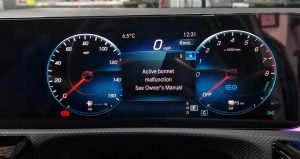Active Bonnet Malfunction
Mercedes are known for building innovation into every detail — even where you might not see it.
Inside the bonnet hinges sits a safety system designed to react in the blink of an eye, lifting the bonnet in a split second during a collision to reduce the force of impact on a pedestrian. It’s technology you hope never to need… but you’d want working perfectly if the moment came. This is the Active Bonnet system.
When that system triggered a fault on a Mercedes A-Class in Dursley, it needed more than a quick guess. At RS Autotechnik, our technicians used Mercedes expertise, structured diagnostics, and dealer-level tooling to uncover the true cause and carry out the repair right the first time. No guesswork, no unnecessary parts — just an accurate fix that restored full safety function.
Here’s how we identified the fault, proved it beyond doubt, and returned the A-Class ready to protect in the moments that matter… without the dealership costs.

Exploring the Mercedes Active Bonnet System
The Active Bonnet system is Mercedes’ solution for reducing injury risk to pedestrians in a collision. Inside the rear bonnet hinges are small pyrotechnic charges, known as squibs, which activate instantly when required. They raise the back of the bonnet by roughly 80mm, creating extra clearance between the bonnet and the hard engine parts beneath. This space acts as an energy-absorbing buffer, helping to reduce the seriousness of an impact with a pedestrian.
The system is controlled by the Supplemental Restraint System (SRS) unit, which works alongside sensors in the front bumper to recognise a qualifying impact. Each hinge has its own lifter, and once triggered, the bonnet remains in a slightly raised position until reset. While the bonnet can be pressed back down so the car can still be driven, the protection it provides is lost until the underlying issue is resolved.
Active Bonnet Malfunction: The First Checks We Made (Fault Code: B2730)
When the Mercedes A-Class was brought into RS Autotechnik, the driver was concerned about a warning on the dashboard: “Active Bonnet Malfunction – see owner’s manual.” This isn’t something that can be ignored. If the system is inactive, the pedestrian safety feature it’s designed to provide won’t be there in the event of a collision.

Our team connected the Mercedes dealer-level diagnostic tool and carried out a complete system scan. This is the same equipment trusted by main dealerships, giving us direct access to factory data and guided test sequences. The scan highlighted a stored fault: B2730 – Left Rear Engine Hood Lifter Squib Malfunction. Put simply, the SRS control unit had detected an issue with the squib inside the left bonnet lifter.
While this gave us the area of concern, our Mercedes specialists know that a code is just the beginning. A stored fault will indicate where the issue has been seen, but not the underlying reason for it. To uncover the cause, we followed a structured diagnostic routine: analysing serial data, checking wiring and connectors, and reviewing other control modules to make sure nothing else was contributing to the fault or waiting to cause another warning.
How We Identified the Problem in the Active Bonnet System
After completing the initial scan, we moved on to a full investigation. At RS Autotechnik in Dursley, this meant using our structured step-by-step diagnostic routine, backed by Mercedes knowledge and the same dealer-level tooling and technical data trusted by main dealerships.
Our first task was to review the official Mercedes information for Fault Code B2730. This confirmed the code related to the squib circuit for the left bonnet lifter. That gave us our direction: find out why the circuit was faulty rather than simply assume the lifter itself was defective.
We then compared serial data between the two lifter circuits. The right-hand circuit responded as expected, but the left showed no activity — a clear sign of an open circuit. This side-by-side test was crucial, as the functioning circuit provided a control reading to prove the fault was both genuine and isolated.
From there, we inspected the wiring harness and connectors feeding the left lifter. We checked for corrosion, damaged pins, or loose fittings, and carried out continuity and resistance tests to ensure the wiring could carry the required signal. All results were within tolerance, proving the wiring was intact.
With wiring and connectors ruled out, and serial data still indicating an open circuit at the left-hand lifter, we concluded that the lifter itself had failed internally. By following this methodical process, we identified the faulty part with certainty, avoided guesswork or unnecessary replacements, and ensured the safety system would soon be back to full strength.
Resolving the Active Bonnet System Fault
With the source of the fault confirmed, we updated the customer to explain what we had found and how the repair would be completed. Keeping the process clear and transparent is vital, especially when dealing with safety-related systems like the Active Bonnet. With approval given, our team followed Mercedes’ strict guidelines for working with pyrotechnic devices: disconnecting the battery and allowing the system to discharge before safely removing the failed left bonnet lifter.
A new lifter was then installed, tightened to the manufacturer’s torque specifications to ensure both accurate alignment and secure fixing. We then carried out a comparison of the left and right bonnet lifter circuits. This step is critical — if skipped, the control unit can continue to store a fault and prevent the system from reactivating.
To complete the repair, we ran a full post-fix evaluation. This meant clearing the stored trouble code, verifying through serial data that the Active Bonnet system was back to full function, and checking that no related errors were present. With all tests completed successfully, the A-Class was returned to its owner with its pedestrian safety system fully restored.
Pedestrian Safety System Restored on the Mercedes A-Class
With the repair complete, this Mercedes A-Class left RS Autotechnik in Dursley with the Active Bonnet Malfunction warning removed and the system working just as it should. The Active Bonnet, an essential part of the car’s pedestrian safety technology, was once again ready to activate in the event of an accident.
By tracing the problem accurately and fitting only the failed component, our team ensured the repair was precise and cost-effective. Using official Mercedes technical data, dealer-level diagnostics, and a proven testing routine, we restored the system to full function on the first attempt, meeting strict safety standards.
For the customer, it meant more than just clearing a fault code. It gave them confidence that their Mercedes’ pedestrian protection system would respond in milliseconds if required, and the reassurance that the repair had been completed to Mercedes standards.
Keep Your Mercedes Safe with RS Autotechnik Dursley
If your Mercedes shows an Active Bonnet Malfunction warning, it’s not something to postpone. The system plays a crucial role in your vehicle’s pedestrian protection, and if it isn’t operating, the safety response won’t be there when it’s needed. If you notice this warning, call the Mercedes specialists at RS Autotechnik on 01453 796345.
Our skilled team in Dursley use a methodical diagnostic process, supported by dealer-level tools and official Mercedes technical data, to find faults accurately the first time and restore your vehicle to full safety standards.
By choosing RS Autotechnik, you’ll also benefit from:
- Free courtesy car while your Mercedes is with us
- 12-month parts and labour guarantee
- Dealer-level expertise without main dealer pricing
- Specialist knowledge of Mercedes safety systems
With a {{average-rating}} star rating on Google from {{review-count}} reviews, our reputation speaks for itself.
Don’t compromise on safety. Call RS Autotechnik on 01453 796345 today to book your Mercedes evaluation and get your Active Bonnet system fully restored.


